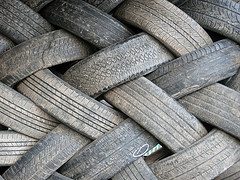(BPT) – If current oil prices, motorist demand and refinery production trends continue, gas prices should drop to between $3.20 and $3.40 per gallon by mid-summer, according to AAA. This is good news for everyone, as the height of travel season quickly approaches. With the majority of travel being done using cars, there will be lots of rubber hitting the road.
What becomes of old vehicle tires, especially large tires like those from a tractor trailer? About one quarter of scrap tires end up in landfills each year, according to the Environmental Protection Agency. Fortunately, a market now exists for 80.4 percent of these tires to be re-used. Some companies have made recycling tires their business, collecting tires from major tire chains, department stores, auto dealers and service stations, and transforming them into rubber crumb.
Other companies, like ECORE, use expired tires to make their own products. This manufacturer is North America’s largest consumer of recycled scrap-tire rubber, reusing more than 80 million pounds of material each year to make rubber flooring. “That’s the equivalent of keeping more than 2,000 trailer loads of discarded tires out of America’s landfills or conserving more than one million barrels of oil,” says Arthur Dodge III, ECORE chairman and CEO.
Most of its recycled scrap-tire rubber comes from the tires of tractor trailers, when the tires are retreaded. Retreading is the process where selected and inspected worn tires, called “casings,” receive a new tread, according to the Tire Retread & Repair Information Bureau. The old tread is then used by ECORE to make rubber flooring. This process occurs at ECORE’s Recycling Technology facility, which grinds, screens and separates the rubber on truck tires to remove contaminants. Most of debris collected is metal that is then sold for reuse in other applications. The remaining rubber crumb is used to create four different types of flooring products. Surfacing made from rubber crumb is safe for the environment and the communities that use them.
There is no known risk associated to human health associated with tire-derived rubber. That is why rubber flooring has become such a popular surfacing option for health care, education, retail, sports and playground installations. In addition to being a green product, rubber surfacing is durable, easy to clean and requires virtually no maintenance.
But you don’t have to be a recycling company or a rubber flooring manufacturer to recycle old tires. Consumers can contact their local recycling organization or trash hauler to find out how to properly dispose of used tires. Most tire stores also offer drop-off services for recycling.
To learn more about solutions that are both environmentally friendly and sustainable recycling tires, visit www.ecoreintl.com.
Related articles





